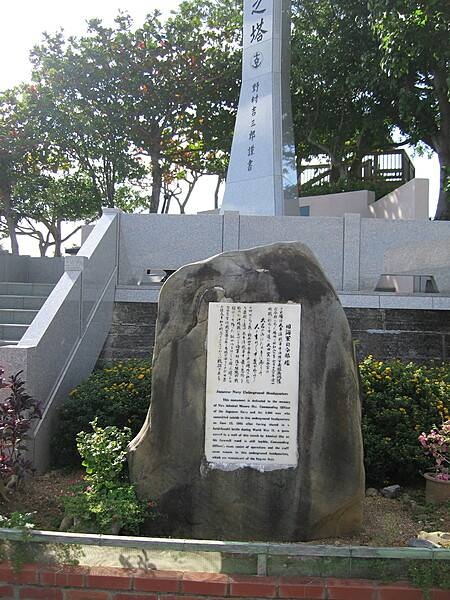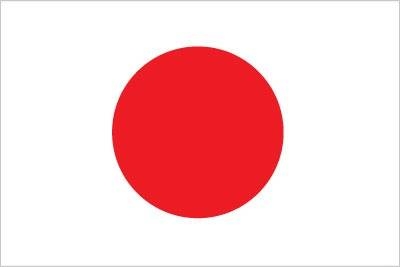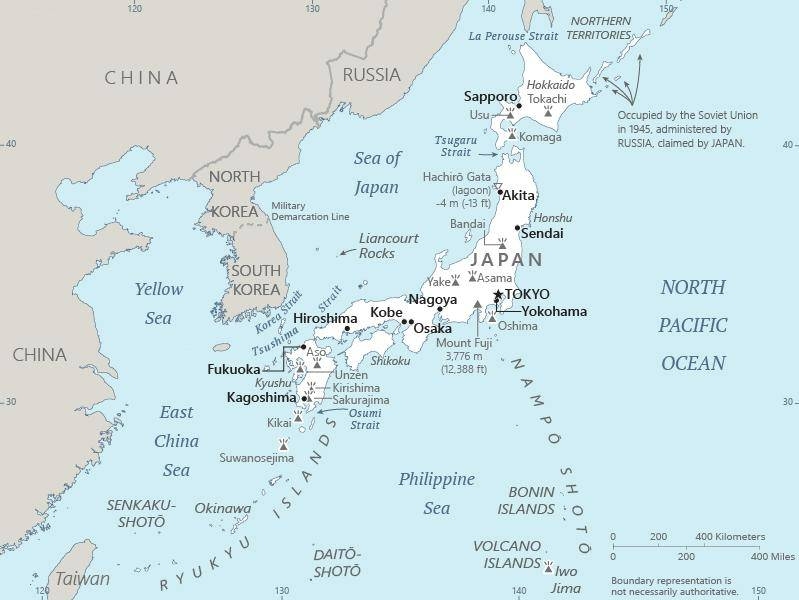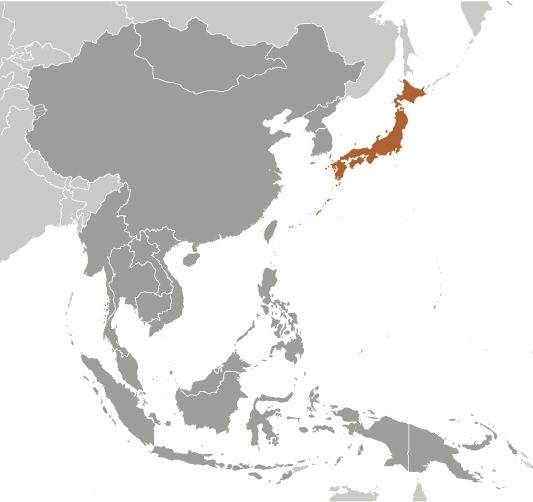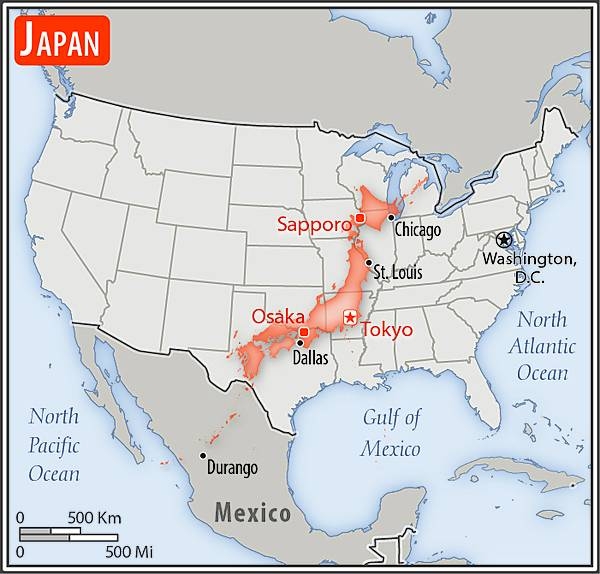Introduction
Background
In 1603, after decades of civil warfare, the Tokugawa shogunate (a military-led, dynastic government) ushered in a long period of relative political stability and isolation from foreign influence. For more than two centuries this policy enabled Japan to enjoy a flowering of its indigenous culture. Japan opened its ports after signing the Treaty of Kanagawa with the US in 1854 and began to intensively modernize and industrialize. During the late 19th and early 20th centuries, Japan became a regional power that was able to defeat the forces of both China and Russia. It occupied Korea, Formosa (Taiwan), and southern Sakhalin Island. In 1931-32 Japan occupied Manchuria, and in 1937 it launched a full-scale invasion of China. Japan attacked US forces in 1941 - triggering America's entry into World War II - and soon occupied much of East and Southeast Asia. After its defeat in World War II, Japan recovered to become an economic power and an ally of the US. While the emperor retains his throne as a symbol of national unity, elected politicians hold actual decision-making power. Following three decades of unprecedented growth, Japan's economy experienced a major slowdown starting in the 1990s, but the country remains an economic power. In March 2011, Japan's strongest-ever earthquake, and an accompanying tsunami, devastated the northeast part of Honshu island, killed thousands, and damaged several nuclear power plants. Prime Minister Shinzo ABE was reelected to office in December 2012, and embarked on ambitious economic and security reforms to improve Japan's economy and bolster the country's international standing. In November 2019, ABE became Japan's longest-serving post-war prime minister; he resigned in September 2020 and was succeeded by Yoshihide SUGA. Fumio KISHIDA became prime minister in October 2021.
Visit the Definitions and Notes page to view a description of each topic.
Geography
Location
Eastern Asia, island chain between the North Pacific Ocean and the Sea of Japan, east of the Korean Peninsula
Geographic coordinates
36 00 N, 138 00 E
Map references
Asia
Area
total: 377,915 sq km
land: 364,485 sq km
water: 13,430 sq km
note: includes Bonin Islands (Ogasawara-gunto), Daito-shoto, Minami-jima, Okino-tori-shima, Ryukyu Islands (Nansei-shoto), and Volcano Islands (Kazan-retto)
Land boundaries
total: 0 km
Coastline
29,751 km
Maritime claims
territorial sea: 12 nm; between 3 nm and 12 nm in the international straits - La Perouse or Soya, Tsugaru, Osumi, and the Korea and Tsushima Straits
contiguous zone: 24 nm
exclusive economic zone: 200 nm
Climate
varies from tropical in south to cool temperate in north
Terrain
mostly rugged and mountainous
Elevation
highest point: Mount Fuji 3,776 m
lowest point: Hachiro-gata -4 m
mean elevation: 438 m
Natural resources
negligible mineral resources, fish; note - with virtually no natural energy resources, Japan is the world's largest importer of coal and liquefied natural gas, as well as the second largest importer of oil
Land use
agricultural land: 12.5% (2018 est.)
arable land: 11.7% (2018 est.)
permanent crops: 0.8% (2018 est.)
permanent pasture: 0% (2018 est.)
forest: 68.5% (2018 est.)
other: 19% (2018 est.)
Irrigated land
15,730 sq km (2014)
Major lakes (area sq km)
fresh water lake(s): Biwa-ko 688 sq km
Population distribution
all primary and secondary regions of high population density lie on the coast; one-third of the population resides in and around Tokyo on the central plain (Kanto Plain)
Natural hazards
many dormant and some active volcanoes; about 1,500 seismic occurrences (mostly tremors but occasional severe earthquakes) every year; tsunamis; typhoons
volcanism: both Unzen (1,500 m) and Sakura-jima (1,117 m), which lies near the densely populated city of Kagoshima, have been deemed Decade Volcanoes by the International Association of Volcanology and Chemistry of the Earth's Interior, worthy of study due to their explosive history and close proximity to human populations; other notable historically active volcanoes include Asama, Honshu Island's most active volcano, Aso, Bandai, Fuji, Iwo-Jima, Kikai, Kirishima, Komaga-take, Oshima, Suwanosejima, Tokachi, Yake-dake, and Usu; see note 2 under "Geography - note"
Geography - note
note 1: strategic location in northeast Asia; composed of four main islands - from north: Hokkaido, Honshu (the largest and most populous), Shikoku, and Kyushu (the "Home Islands") - and 6,848 smaller islands and islets
note 2: Japan annually records the most earthquakes in the world; it is one of the countries along the Ring of Fire, a belt of active volcanoes and earthquake epicenters bordering the Pacific Ocean; up to 90% of the world's earthquakes and some 75% of the world's volcanoes occur within the Ring of Fire
People and Society
Nationality
noun: Japanese (singular and plural)
adjective: Japanese
Ethnic groups
Japanese 97.9%, Chinese 0.6%, Korean 0.4%, other 1.1% (includes Vietnamese, Filipino, and Brazilian) (2017 est.)
note: data represent population by nationality; up to 230,000 Brazilians of Japanese origin migrated to Japan in the 1990s to work in industries; some have returned to Brazil
Languages
Japanese
major-language sample(s):
必要不可欠な基本情報の源、ワールド・ファクトブック(Japanese)
The World Factbook, the indispensable source for basic information.
Religions
Shintoism 70.5%, Buddhism 67.2%, Christianity 1.5%, other 5.9% (2019 est.)
note: total adherents exceeds 100% because many people practice both Shintoism and Buddhism
Age structure
0-14 years: 12.49% (male 8,047,183/female 7,623,767)
15-24 years: 9.47% (male 6,254,352/female 5,635,377)
25-54 years: 36.8% (male 22,867,385/female 23,317,140)
55-64 years: 12.06% (male 7,564,067/female 7,570,732)
65 years and over: 29.18% (male 16,034,973/female 20,592,496) (2020 est.)
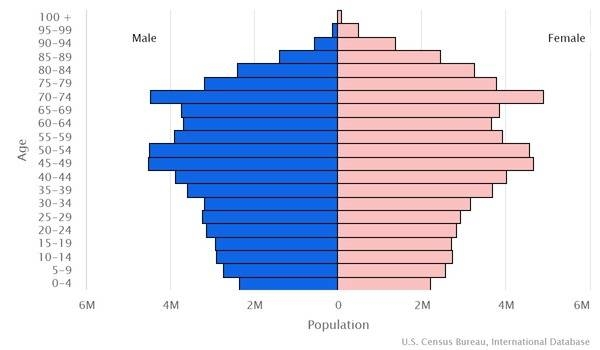
Dependency ratios
total dependency ratio: 71.1
youth dependency ratio: 20.1
elderly dependency ratio: 51
potential support ratio: 2 (2021 est.)
Median age
total: 48.6 years
male: 47.2 years
female: 50 years (2020 est.)
Population distribution
all primary and secondary regions of high population density lie on the coast; one-third of the population resides in and around Tokyo on the central plain (Kanto Plain)
Urbanization
urban population: 92% of total population (2023)
rate of urbanization: -0.25% annual rate of change (2020-25 est.)
Major urban areas - population
37.194 million TOKYO (capital), 19.013 million Osaka, 9.569 million Nagoya, 5.490 million Kitakyushu-Fukuoka, 2.937 million Shizuoka-Hamamatsu, 2.666 million Sapporo (2023)
Sex ratio
at birth: 1.06 male(s)/female
0-14 years: 1.06 male(s)/female
15-24 years: 1.09 male(s)/female
25-54 years: 1 male(s)/female
55-64 years: 1 male(s)/female
65 years and over: 0.65 male(s)/female
total population: 0.95 male(s)/female (2022 est.)
Mother's mean age at first birth
30.7 years (2018 est.)
Maternal mortality ratio
5 deaths/100,000 live births (2017 est.)
country comparison to the world: 166Infant mortality rate
total: 1.9 deaths/1,000 live births
male: 2 deaths/1,000 live births
female: 1.79 deaths/1,000 live births (2022 est.)
Life expectancy at birth
total population: 84.83 years
male: 81.92 years
female: 87.9 years (2022 est.)
Contraceptive prevalence rate
39.8% (2015)
note: percent of women aged 20-49
Drinking water source
improved: urban: NA
rural: NA
total: 99.1% of population
unimproved: urban: NA
rural: NA
total: 0.1% of population (2020 est.)
Current health expenditure
10.7% of GDP (2019)
Physicians density
2.48 physicians/1,000 population (2018)
Hospital bed density
13 beds/1,000 population (2018)
Sanitation facility access
improved: urban: NA
rural: NA
total: 99.9% of population
unimproved: urban: NA
rural: NA
total: 0.1% of population (2020 est.)
Major infectious diseases
respiratory diseases: Covid-19 (see note) (2020)
note: clusters of cases of respiratory illness caused by a new coronavirus (COVID-19) in Japan; illness with this virus has ranged from mild to severe with fatalities reported; as of 9 December 2022, Japan has reported a total of 25,687,798 cases of COVID-19 or 20,310.33 cumulative cases of COVID-19 per 100,000 population with a total of 51,062 cumulative deaths or a rate of 40.37 cumulative deaths per 100,000 population; as of 8 December 2022, 84.27% of the population has received at least one dose of COVID-19 vaccine
Alcohol consumption per capita
total: 8.36 liters of pure alcohol (2019 est.)
beer: 1.35 liters of pure alcohol (2019 est.)
wine: 0.29 liters of pure alcohol (2019 est.)
spirits: 1.63 liters of pure alcohol (2019 est.)
other alcohols: 5.09 liters of pure alcohol (2019 est.)
Tobacco use
total: 20.1% (2020 est.)
male: 30.1% (2020 est.)
female: 10% (2020 est.)
Literacy
total population: NA
male: NA
female: NA
School life expectancy (primary to tertiary education)
total: 15 years
male: 15 years
female: 15 years (2019)
Youth unemployment rate (ages 15-24)
total: 4.6%
male: 5.1%
female: 4.2% (2021 est.)
Environment
Environment - current issues
air pollution from power plant emissions results in acid rain; acidification of lakes and reservoirs degrading water quality and threatening aquatic life; Japan is one of the largest consumers of fish and tropical timber, contributing to the depletion of these resources in Asia and elsewhere; following the 2011 Fukushima nuclear disaster, Japan originally planned to phase out nuclear power, but it has now implemented a new policy of seeking to restart nuclear power plants that meet strict new safety standards; waste management is an ongoing issue; Japanese municipal facilities used to burn high volumes of trash, but air pollution issues forced the government to adopt an aggressive recycling policy
Environment - international agreements
party to: Antarctic-Environmental Protection, Antarctic-Marine Living Resources, Antarctic Seals, Antarctic Treaty, Biodiversity, Climate Change, Climate Change-Kyoto Protocol, Climate Change-Paris Agreement, Comprehensive Nuclear Test Ban, Desertification, Endangered Species, Environmental Modification, Hazardous Wastes, Law of the Sea, Marine Dumping-London Convention, Marine Dumping-London Protocol, Nuclear Test Ban, Ozone Layer Protection, Ship Pollution, Tropical Timber 2006, Wetlands
signed, but not ratified: none of the selected agreements
Air pollutants
particulate matter emissions: 11.45 micrograms per cubic meter (2016 est.)
carbon dioxide emissions: 1,135.89 megatons (2016 est.)
methane emissions: 29.99 megatons (2020 est.)
Climate
varies from tropical in south to cool temperate in north
Land use
agricultural land: 12.5% (2018 est.)
arable land: 11.7% (2018 est.)
permanent crops: 0.8% (2018 est.)
permanent pasture: 0% (2018 est.)
forest: 68.5% (2018 est.)
other: 19% (2018 est.)
Urbanization
urban population: 92% of total population (2023)
rate of urbanization: -0.25% annual rate of change (2020-25 est.)
Revenue from forest resources
forest revenues: 0.02% of GDP (2018 est.)
country comparison to the world: 141Major infectious diseases
respiratory diseases: Covid-19 (see note) (2020)
note: clusters of cases of respiratory illness caused by a new coronavirus (COVID-19) in Japan; illness with this virus has ranged from mild to severe with fatalities reported; as of 9 December 2022, Japan has reported a total of 25,687,798 cases of COVID-19 or 20,310.33 cumulative cases of COVID-19 per 100,000 population with a total of 51,062 cumulative deaths or a rate of 40.37 cumulative deaths per 100,000 population; as of 8 December 2022, 84.27% of the population has received at least one dose of COVID-19 vaccine
Waste and recycling
municipal solid waste generated annually: 43.981 million tons (2015 est.)
municipal solid waste recycled annually: 2,155,069 tons (2015 est.)
percent of municipal solid waste recycled: 4.9% (2015 est.)
Major lakes (area sq km)
fresh water lake(s): Biwa-ko 688 sq km
Total water withdrawal
municipal: 15.41 billion cubic meters (2017 est.)
industrial: 11.61 billion cubic meters (2017 est.)
agricultural: 54.43 billion cubic meters (2017 est.)
Total renewable water resources
430 billion cubic meters (2017 est.)
Government
Country name
conventional long form: none
conventional short form: Japan
local long form: Nihon-koku/Nippon-koku
local short form: Nihon/Nippon
etymology: the English word for Japan comes via the Chinese name for the country "Cipangu"; both Nihon and Nippon mean "where the sun originates" and are frequently translated as "Land of the Rising Sun"
Government type
parliamentary constitutional monarchy
Capital
name: Tokyo
geographic coordinates: 35 41 N, 139 45 E
time difference: UTC+9 (14 hours ahead of Washington, DC, during Standard Time)
etymology: originally known as Edo, meaning "estuary" in Japanese, the name was changed to Tokyo, meaning "eastern capital," in 1868
Administrative divisions
47 prefectures; Aichi, Akita, Aomori, Chiba, Ehime, Fukui, Fukuoka, Fukushima, Gifu, Gunma, Hiroshima, Hokkaido, Hyogo, Ibaraki, Ishikawa, Iwate, Kagawa, Kagoshima, Kanagawa, Kochi, Kumamoto, Kyoto, Mie, Miyagi, Miyazaki, Nagano, Nagasaki, Nara, Niigata, Oita, Okayama, Okinawa, Osaka, Saga, Saitama, Shiga, Shimane, Shizuoka, Tochigi, Tokushima, Tokyo, Tottori, Toyama, Wakayama, Yamagata, Yamaguchi, Yamanashi
Independence
3 May 1947 (current constitution adopted as amendment to Meiji Constitution); notable earlier dates: 11 February 660 B.C. (mythological date of the founding of the nation by Emperor JIMMU); 29 November 1890 (Meiji Constitution provides for constitutional monarchy)
National holiday
Birthday of Emperor NARUHITO, 23 February (1960); note - celebrates the birthday of the current emperor
Constitution
history: previous 1890; latest approved 6 October 1946, adopted 3 November 1946, effective 3 May 1947
amendments: proposed by the Diet; passage requires approval by at least two-thirds majority of both houses of the Diet and approval by majority in a referendum; note - the constitution has not been amended since its enactment in 1947
Legal system
civil law system based on German model; system also reflects Anglo-American influence and Japanese traditions; judicial review of legislative acts in the Supreme Court
International law organization participation
accepts compulsory ICJ jurisdiction with reservations; accepts ICCt jurisdiction
Citizenship
citizenship by birth: no
citizenship by descent only: at least one parent must be a citizen of Japan
dual citizenship recognized: no
residency requirement for naturalization: 5 years
Suffrage
18 years of age; universal
Executive branch
chief of state: Emperor NARUHITO (since 1 May 2019); note - succeeds his father who abdicated on 30 April 2019
head of government: Prime Minister Fumio KISHIDA (since 4 October 2021 )
cabinet: Cabinet appointed by the prime minister
elections/appointments: the monarchy is hereditary; the leader of the majority party or majority coalition in the House of Representatives usually becomes prime minister
election results: Fumio KISHIDA relected prime minister on 10 November 2021 by the lower house with 297 votes against 108 for Yukio EDANO and in the upper houese 141 for KISHIDA and 60 for EDANO
Legislative branch
description: bicameral Diet or Kokkai consists of:
House of Councillors or Sangi-in (245 seats, currently 242; 146 members directly elected in multi-seat districts by simple majority vote and 96 directly elected in a single national constituency by proportional representation vote; members serve 6-year terms with half the membership renewed every 3 years); note - the number of seats increases to 248 at the July 2022 election for renewal of half the membership
House of Representatives or Shugi-in (465 seats; 289 members directly elected in single-seat districts by simple majority vote and 176 directly elected in multi-seat districts by party-list proportional representation vote; members serve 4-year terms)
elections:
House of Councillors - last held on 21 July 2019 (next to be held in July 2022)
House of Representatives - last held on 31 October 2021 (next to be held by October 2025)
election results:
House of Councillors - percent of vote by party - NA; seats by party - LDP 55, DP 32, Komeito 14, JCP 6, Osaka Ishin no Kai (Initiatives from Osaka) 7, PLPTYF 1, SDP 1, independent 5; composition - men 186, women 56, percent of women 21.3%
House of Representatives - percent of vote by party - NA; seats by party - LDP 261, CDP 96, Ishin 41, Komeito 32, DPFP 11, JCP 10, Reiwa 3, SDP 1, independent 10; composition - men 420, women 45, percent of women 9.7%; note - total Diet percent of women 14.7%
note: the Diet in June 2017 redrew Japan's electoral district boundaries and reduced from 475 to 465 seats in the House of Representatives; the amended electoral law, which cuts 6 seats in single-seat districts and 4 in multi-seat districts, was reportedly intended to reduce voting disparities between densely and sparsely populated voting districts
Judicial branch
highest court(s): Supreme Court or Saiko saibansho (consists of the chief justice and 14 associate justices); note - the Supreme Court has jurisdiction in constitutional issues
judge selection and term of office: Supreme Court chief justice designated by the Cabinet and appointed by the monarch; associate justices appointed by the Cabinet and confirmed by the monarch; all justices are reviewed in a popular referendum at the first general election of the House of Representatives following each judge's appointment and every 10 years afterward
subordinate courts: 8 High Courts (Koto-saiban-sho), each with a Family Court (Katei-saiban-sho); 50 District Courts (Chiho saibansho), with 203 additional branches; 438 Summary Courts (Kani saibansho)
Political parties and leaders
Constitutional Democratic Party of Japan or CDP [Kenta IZUMI]
Democratic Party for the People Japan or DPFP [Yuichiro TAMAKI]
Group of Reformists [Sakihito OZAWA]
Japan Communist Party or JCP [Kazuo SHII]
Japan Innovation Party or Nippon Ishin no kai or Ishin [Ichiro MATSUI]
Komeito [Natsuo YAMAGUCHI]
Liberal Democratic Party or LDP [Fumio KISHIDA]
Liberal Party [Ichiro OZAWA] (formerly People's Life Party & Taro Yamamoto and Friends or PLPTYF)
Party of Hope or Kibo no To [Nariaki NAKAYAMA]
Reiwa Shinsengumi [Taro YAMAMOTO]
Social Democratic Party or SDP [Mizuho FUKUSHIMA]
International organization participation
ADB, AfDB (nonregional member), APEC, Arctic Council (observer), ARF, ASEAN (dialogue partner), Australia Group, BIS, CD, CE (observer), CERN (observer), CICA (observer), CP, CPLP (associate), EAS, EBRD, EITI (implementing country), FAO, FATF, G-5, G-7, G-8, G-10, G-20, IADB, IAEA, IBRD, ICAO, ICC (national committees), ICCt, ICRM, IDA, IEA, IFAD, IFC, IFRCS, IGAD (partners), IHO, ILO, IMF, IMO, IMSO, Interpol, IOC, IOM, IPU, ISO, ITSO, ITU, ITUC (NGOs), LAIA (observer), MIGA, NEA, NSG, OAS (observer), OECD, OPCW, OSCE (partner), Pacific Alliance (observer), Paris Club, PCA, PIF (partner), Quad, SAARC (observer), SELEC (observer), SICA (observer), UN, UNCTAD, UNESCO, UNHCR, UNHRC, UNIDO, UNMISS, UNRWA, UNWTO, UPU, Wassenaar Arrangement, WCO, WFTU (NGOs), WHO, WIPO, WMO, WTO, ZC
Diplomatic representation in the US
chief of mission: Ambassador TOMITA Koji (since 17 February 2021)
chancery: 2520 Massachusetts Avenue NW, Washington, DC 20008
telephone: [1] (202) 238-6700
FAX: [1] (202) 328-2187
email address and website:
https://www.us.emb-japan.go.jp/itprtop_en/index.html
consulate(s) general: Anchorage (AK), Atlanta, Boston, Chicago, Denver (CO), Detroit (MI), Hagatna (Guam), Honolulu, Houston, Los Angeles, Miami, Nashville (TN), New York, Portland (OR), San Francisco, Saipan (Northern Mariana Islands), Seattle (WA)
Diplomatic representation from the US
chief of mission: Ambassador Rahm EMANUEL (since 25 March 2022)
embassy: 1-10-5 Akasaka, Minato-ku, Tokyo 107-8420
mailing address: 9800 Tokyo Place, Washington DC 20521-9800
telephone: [81] (03) 3224-5000
FAX: [81] (03) 3224-5856
email address and website:
TokyoACS@state.gov
https://jp.usembassy.gov/
consulate(s) general: Naha (Okinawa), Osaka-Kobe, Sapporo
consulate(s): Fukuoka, Nagoya
Flag description
white with a large red disk (representing the sun without rays) in the center
National symbol(s)
red sun disc, chrysanthemum; national colors: red, white
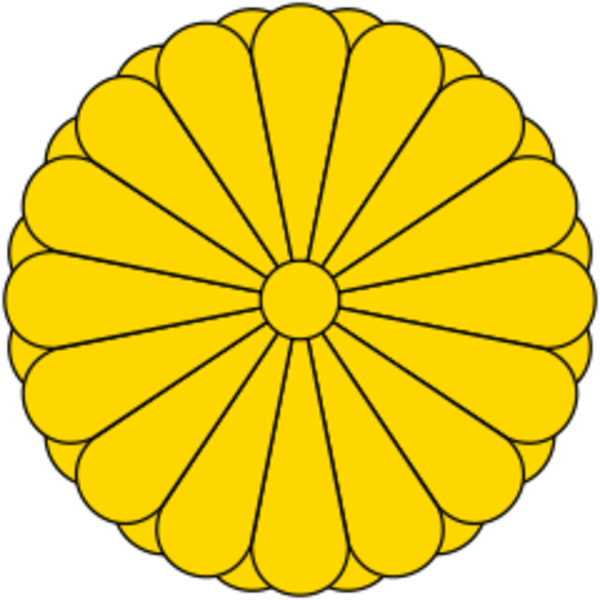
National anthem
name: "Kimigayo" (The Emperor's Reign)
lyrics/music: unknown/Hiromori HAYASHI
note: adopted 1999; unofficial national anthem since 1883; oldest anthem lyrics in the world, dating to the 10th century or earlier; there is some opposition to the anthem because of its association with militarism and worship of the emperor
National heritage
total World Heritage Sites: 25 (20 cultural, 5 natural)
selected World Heritage Site locales: Buddhist Monuments in the Horyu-ji Area (c); Historic Monuments of Ancient Nara (c); Himeji-jo (c); Shiretoko (n); Mozu-Furuichi Kofun Group: Mounded Tombs of Ancient Japan (c); Iwami Ginzan Silver Mine and its Cultural Landscape (c); Jomon Prehistoric Sites in Northern Japan (c); Yakushima (n); Historic Monuments of Ancient Kyoto (c); Hiroshima Peace Memorial (Genbaku Dome) (c)
Economy
Economic overview
Over the past 70 years, government-industry cooperation, a strong work ethic, mastery of high technology, and a comparatively small defense allocation (slightly less than 1% of GDP) have helped Japan develop an advanced economy. Two notable characteristics of the post-World War II economy were the close interlocking structures of manufacturers, suppliers, and distributors, known as keiretsu, and the guarantee of lifetime employment for a substantial portion of the urban labor force. Both features have significantly eroded under the dual pressures of global competition and domestic demographic change.
Measured on a purchasing power parity basis that adjusts for price differences, Japan in 2017 stood as the fourth-largest economy in the world after first-place China, which surpassed Japan in 2001, and third-place India, which edged out Japan in 2012. For three postwar decades, overall real economic growth was impressive - averaging 10% in the 1960s, 5% in the 1970s, and 4% in the 1980s. Growth slowed markedly in the 1990s, averaging just 1.7%, largely because of the aftereffects of inefficient investment and the collapse of an asset price bubble in the late 1980s, which resulted in several years of economic stagnation as firms sought to reduce excess debt, capital, and labor. Modest economic growth continued after 2000, but the economy has fallen into recession four times since 2008.
Japan enjoyed an uptick in growth since 2013, supported by Prime Minister Shinzo ABE’s "Three Arrows" economic revitalization agenda - dubbed "Abenomics" - of monetary easing, "flexible" fiscal policy, and structural reform. Led by the Bank of Japan’s aggressive monetary easing, Japan is making modest progress in ending deflation, but demographic decline – a low birthrate and an aging, shrinking population – poses a major long-term challenge for the economy. The government currently faces the quandary of balancing its efforts to stimulate growth and institute economic reforms with the need to address its sizable public debt, which stands at 235% of GDP. To help raise government revenue, Japan adopted legislation in 2012 to gradually raise the consumption tax rate. However, the first such increase, in April 2014, led to a sharp contraction, so Prime Minister ABE has twice postponed the next increase, which is now scheduled for October 2019. Structural reforms to unlock productivity are seen as central to strengthening the economy in the long-run.
Scarce in critical natural resources, Japan has long been dependent on imported energy and raw materials. After the complete shutdown of Japan’s nuclear reactors following the earthquake and tsunami disaster in 2011, Japan's industrial sector has become even more dependent than before on imported fossil fuels. However, ABE’s government is seeking to restart nuclear power plants that meet strict new safety standards and is emphasizing nuclear energy’s importance as a base-load electricity source. In August 2015, Japan successfully restarted one nuclear reactor at the Sendai Nuclear Power Plant in Kagoshima prefecture, and several other reactors around the country have since resumed operations; however, opposition from local governments has delayed several more restarts that remain pending. Reforms of the electricity and gas sectors, including full liberalization of Japan’s energy market in April 2016 and gas market in April 2017, constitute an important part of Prime Minister Abe’s economic program.
Under the Abe Administration, Japan’s government sought to open the country’s economy to greater foreign competition and create new export opportunities for Japanese businesses, including by joining 11 trading partners in the Trans-Pacific Partnership (TPP). Japan became the first country to ratify the TPP in December 2016, but the United States signaled its withdrawal from the agreement in January 2017. In November 2017 the remaining 11 countries agreed on the core elements of a modified agreement, which they renamed the Comprehensive and Progressive Agreement for Trans-Pacific Partnership (CPTPP). Japan also reached agreement with the European Union on an Economic Partnership Agreement in July 2017, and is likely seek to ratify both agreements in the Diet this year.
Real GDP (purchasing power parity)
$5,224,850,000,000 (2019 est.) note: data are in 2017 dollars
$5,210,770,000,000 (2018 est.) note: data are in 2017 dollars
$5,180,326,000,000 (2017 est.)
Real GDP growth rate
0.7% (2019 est.)
0.29% (2018 est.)
2.19% (2017 est.)
Real GDP per capita
$41,400 (2019 est.) note: data are in 2017 dollars
$41,200 (2018 est.) note: data are in 2017 dollars
$40,859 (2017 est.)
GDP (official exchange rate)
$5,078,679,000,000 (2019 est.)
Inflation rate (consumer prices)
0.4% (2019 est.)
0.9% (2018 est.)
0.4% (2017 est.)
Credit ratings
Fitch rating: A (2015)
Moody's rating: A1 (2014)
Standard & Poors rating: A+ (2015)
note: The year refers to the year in which the current credit rating was first obtained.
GDP - composition, by sector of origin
agriculture: 1.1% (2017 est.)
industry: 30.1% (2017 est.)
services: 68.7% (2017 est.)
GDP - composition, by end use
household consumption: 55.5% (2017 est.)
government consumption: 19.6% (2017 est.)
investment in fixed capital: 24% (2017 est.)
investment in inventories: 0% (2017 est.)
exports of goods and services: 17.7% (2017 est.)
imports of goods and services: -16.8% (2017 est.)
Agricultural products
rice, milk, sugar beet, vegetables, eggs, poultry, potatoes, cabbages, onions, pork
Industries
among world's largest and most technologically advanced producers of motor vehicles, electronic equipment, machine tools, steel and nonferrous metals, ships, chemicals, textiles, processed foods
Labor force - by occupation
agriculture: 2.9%
industry: 26.2%
services: 70.9% (February 2015 est.)
Youth unemployment rate (ages 15-24)
total: 4.6%
male: 5.1%
female: 4.2% (2021 est.)
Population below poverty line
16.1% (2013 est.)
Gini Index coefficient - distribution of family income
32.9 (2013 est.)
24.9 (1993)
Household income or consumption by percentage share
lowest 10%: 2.7%
highest 10%: 24.8% (2008)
Budget
revenues: 1.714 trillion (2017 est.)
expenditures: 1.885 trillion (2017 est.)
Fiscal year
1 April - 31 March
Current account balance
$185.644 billion (2019 est.)
$177.08 billion (2018 est.)
Exports
$793.32 billion (2020 est.) note: data are in current year dollars
$904.63 billion (2019 est.) note: data are in current year dollars
$929.83 billion (2018 est.) note: data are in current year dollars
Exports - partners
United States 19%, China 18%, South Korea 6%, Taiwan 6% (2019)
Exports - commodities
cars and vehicle parts, integrated circuits, personal appliances, ships (2019)
Imports
$799.52 billion (2020 est.) note: data are in current year dollars
$913.25 billion (2019 est.) note: data are in current year dollars
$928.42 billion (2018 est.) note: data are in current year dollars
Imports - partners
China 23%, United States 11%, Australia 6% (2019)
Imports - commodities
crude petroleum, natural gas, coal, integrated circuits, broadcasting equipment (2019)
Reserves of foreign exchange and gold
$1.264 trillion (31 December 2017 est.)
$1.233 trillion (31 December 2015 est.)
Debt - external
$4,254,271,000,000 (2019 est.)
$3,944,898,000,000 (2018 est.)
Exchange rates
yen (JPY) per US dollar -
104.205 (2020 est.)
108.605 (2019 est.)
112.7 (2018 est.)
121.02 (2014 est.)
97.44 (2013 est.)
Energy
Electricity access
electrification - total population: 100% (2020)
Electricity
installed generating capacity: 348.666 million kW (2020 est.)
consumption: 903,698,740,000 kWh (2019 est.)
exports: 0 kWh (2020 est.)
imports: 0 kWh (2020 est.)
transmission/distribution losses: 44.094 billion kWh (2019 est.)
Electricity generation sources
fossil fuels: 73.5% of total installed capacity (2020 est.)
nuclear: 4.8% of total installed capacity (2020 est.)
solar: 8.8% of total installed capacity (2020 est.)
wind: 1% of total installed capacity (2020 est.)
hydroelectricity: 10% of total installed capacity (2020 est.)
tide and wave: 0% of total installed capacity (2020 est.)
geothermal: 0.3% of total installed capacity (2020 est.)
biomass and waste: 1.6% of total installed capacity (2020 est.)
Coal
production: 29.84 million metric tons (2020 est.)
consumption: 210.882 million metric tons (2020 est.)
exports: 3.201 million metric tons (2020 est.)
imports: 174.486 million metric tons (2020 est.)
proven reserves: 350 million metric tons (2019 est.)
Petroleum
total petroleum production: 10,200 bbl/day (2021 est.)
refined petroleum consumption: 3,739,300 bbl/day (2019 est.)
crude oil and lease condensate exports: 0 bbl/day (2018 est.)
crude oil and lease condensate imports: 3,012,800 bbl/day (2018 est.)
crude oil estimated reserves: 44.1 million barrels (2021 est.)
Refined petroleum products - production
3.467 million bbl/day (2017 est.)
country comparison to the world: 5Refined petroleum products - imports
1.1 million bbl/day (2017 est.)
country comparison to the world: 5Natural gas
production: 1,928,431,000 cubic meters (2020 est.)
consumption: 102,108,738,000 cubic meters (2019 est.)
exports: 28,000 cubic meters (2019 est.)
imports: 105,255,103,000 cubic meters (2019 est.)
proven reserves: 20.898 billion cubic meters (2021 est.)
Carbon dioxide emissions
1,103,234,000 metric tonnes of CO2 (2019 est.)
from coal and metallurgical coke: 439.243 million metric tonnes of CO2 (2019 est.)
from petroleum and other liquids: 444.271 million metric tonnes of CO2 (2019 est.)
from consumed natural gas: 219.72 million metric tonnes of CO2 (2019 est.)
Energy consumption per capita
147.107 million Btu/person (2019 est.)
country comparison to the world: 35Communications
Telephones - fixed lines
total subscriptions: 61,978,594 (2020 est.)
subscriptions per 100 inhabitants: 49 (2020 est.)
Telephones - mobile cellular
total subscriptions: 195,054,893 (2020 est.)
subscriptions per 100 inhabitants: 154 (2020 est.)
Telecommunication systems
general assessment: Japan has one of the best developed telecom markets globally, the fixed-line segment remains stagnant and the focus for growth is in the mobile sector; the MNOs have shifted their investment from LTE to 5G, and growth in 5G showed early promise although there have been recent setbacks; these have partly been attributed to the economic difficulties, the impact of restrictions imposed during the pandemic, and unfavourable investment climate (not helped by the delay of the Tokyo Olympics from 2020 to 2021), and to restrictions in the supply of 5G-enabled devices; the fixed broadband market is dominated by fiber, with a strong cable platform also evident; fiber will continue to increase its share of the fixed broadband market, largely at the expense of DSL; the mobile market is dominated by three MNOs, mobile broadband subscriber growth is expected to be relatively low over the next five years, partly due to the high existing subscriptions though growth has been stimulated by measures which have encouraged people to school and work from home; there has also been a boost in accessing entertainment via mobile devices since 2020; plans to provide 55% population coverage with 5G by March 2022 and nationwide 5G coverage by 2023 (2021)
domestic: high level of modern technology and excellent service of every kind; 49 per 100 for fixed-line and 152 per 100 for mobile-cellular subscriptions (2020)
international: country code - 81; numerous submarine cables with landing points for HSCS, JIH, RJCN, APCN-2, JUS, EAC-C2C, PC-1, Tata TGN-Pacific, FLAG North Asia Loop/REACH North Asia Loop, APCN-2, FASTER, SJC, SJC2, Unity/EAC-Pacific, JGA-N, APG, ASE, AJC, JUPITER, MOC, Okinawa Cellular Cable, KJCN, GOKI, KJCN, and SeaMeWE-3, submarine cables provide links throughout Asia, Australia, the Middle East, Europe, Southeast Asia, Africa and US; satellite earth stations - 7 Intelsat (Pacific and Indian Oceans), 1 Intersputnik (Indian Ocean region), 2 Inmarsat (Pacific and Indian Ocean regions), and 8 SkyPerfect JSAT (2019)
note: the COVID-19 pandemic continues to have a significant impact on production and supply chains globally; since 2020, some aspects of the telecom sector have experienced a downturn, particularly in mobile device production; progress toward 5G implementation has resumed, as well as upgrades to infrastructure; consumer spending on telecom services has increased due to the surge in demand for capacity and bandwidth; the crucial nature of telecom services as a tool for work and school from home is still evident, and the spike in this area has seen growth opportunities for development of new tools and increased services
Broadcast media
a mixture of public and commercial broadcast TV and radio stations; 6 national terrestrial TV networks including 1 public broadcaster; the large number of radio and TV stations available provide a wide range of choices; satellite and cable services provide access to international channels (2019)
Internet users
total: 113,252,419 (2020 est.)
percent of population: 90% (2020 est.)
Broadband - fixed subscriptions
total: 44,000,791 (2020 est.)
subscriptions per 100 inhabitants: 35 (2020 est.)
Transportation
National air transport system
number of registered air carriers: 22 (2020)
inventory of registered aircraft operated by air carriers: 673
annual passenger traffic on registered air carriers: 126,387,527 (2018)
annual freight traffic on registered air carriers: 9,420,660,000 (2018) mt-km
Airports - with paved runways
total: 142
over 3,047 m: 6
2,438 to 3,047 m: 45
1,524 to 2,437 m: 38
914 to 1,523 m: 28
under 914 m: 25 (2021)
Airports - with unpaved runways
total: 33
914 to 1,523 m: 5
under 914 m: 28 (2021)
Heliports
16 (2021)
Pipelines
4,456 km gas, 174 km oil, 104 km oil/gas/water (2013)
Railways
total: 27,311 km (2015)
standard gauge: 4,800 km (2015) 1.435-m gauge (4,800 km electrified)
narrow gauge: 124 km (2015) 1.372-m gauge (124 km electrified)
dual gauge: 132 km (2015) 1.435-1.067-m gauge (132 km electrified)
22,207 km 1.067-mm gauge (15,430 km electrified)
48 km 0.762-m gauge (48 km electrified)
Roadways
total: 1,218,772 km (2015)
paved: 992,835 km (2015) (includes 8,428 km of expressways)
unpaved: 225,937 km (2015)
Merchant marine
total: 5,201
by type: bulk carrier 148, container ship 45, general cargo 1,900, oil tanker 666, other 2,442 (2021)
Ports and terminals
major seaport(s): Chiba, Kawasaki, Kobe, Mizushima, Moji, Nagoya, Osaka, Tokyo, Tomakomai, Yokohama
container port(s) (TEUs): Kobe (2,871,642), Nagoya (2,844,004), Osaka (2,456,028), Tokyo (4,510,000), Yokohama (2,990,000) (2019)
LNG terminal(s) (import): Chita, Fukwoke, Futtsu, Hachinone, Hakodate, Hatsukaichi, Higashi Ohgishima, Higashi Niigata, Himeiji, Joetsu, Kagoshima, Kawagoe, Kita Kyushu, Mizushima, Nagasaki, Naoetsu, Negishi, Ohgishima, Oita, Sakai, Sakaide, Senboku, Shimizu, Shin Minato, Sodegaura, Tobata, Yanai, Yokkaichi
Okinawa - Nakagusuku
Transportation - note
Japan operates one PC 3 or 4 class medium icebreaker
note - PC indicates a Polar Class vessel: PC 3 - year-round operation in second-year ice which may include multi-year ice inclusions (ice thickness up to 2.5 m); PC 4 - year-round operation in thick first-year ice which may include old ice inclusions (ice thickness up to 120 cm)
Military and Security
Military and security forces
Japan Self-Defense Force (JSDF): Ground Self-Defense Force (Rikujou Jieitai, GSDF; includes aviation), Maritime Self-Defense Force (Kaijou Jieitai, MSDF; includes naval aviation), Air Self-Defense Force (Koukuu Jieitai, ASDF); Japan Coast Guard (Ministry of Land, Transport, Infrastructure and Tourism) (2022)
Military expenditures
1% of GDP (2022 est.)
1% of GDP (2021)
1% of GDP (2020)
0.9% of GDP (2019) (approximately $53.4 billion)
0.9% of GDP (2018) (approximately $53.5 billion)
note: the Japanese Government in 2022 pledged to "substantially" increase defense spending in the next few years to counter what Tokyo sees as a growing security threat posed by China
Military and security service personnel strengths
approximately 240,000 active personnel (150,000 Ground; 45,000 Maritime; 45,000 Air); 14,000 Coast Guard (2022)
Military equipment inventories and acquisitions
the JSDF is equipped with a mix of imported and domestically-produced equipment; Japan has a robust defense industry and is capable of producing a wide range of air, ground, and naval weapons systems; the majority of its weapons imports are from the US and some domestically-produced weapons are US-origin and manufactured under license (2022)
Military service age and obligation
18 years of age for voluntary military service for men and women (maximum enlistment age 32); no conscription (2022)
note: as of 2020, women made up about 7% of the military's full-time personnel
Military deployments
approximately 180 Djibouti (2022)
Military - note
Japan was disarmed after its defeat in World War II; shortly after the Korean War began in 1950, US occupation forces in Japan created a 75,000-member lightly armed force called the National Police Reserve; the current Self Defense Force was founded in 1954
in addition to having one of the region’s largest and best equipped militaries, Japan’s alliance with the US (signed in 1951) is one of the cornerstones of the country’s security, as well as a large part of the US security role in Asia; as of 2022, approximately 55,000 US troops and other military assets, including aircraft and naval ships, were stationed in Japan and had exclusive use of more than 80 bases and facilities; in exchange for their use, the US guarantees Japan’s security; the Japanese Government provides about $2 billion per year to offset the cost of stationing US forces in Japan; in addition, it pays compensation to localities hosting US troops, rent for bases, and costs for new facilities to support the US presence
Japan has Major Non-NATO Ally (MNNA) status with the US; MNNA is a designation under US law that provides foreign partners with certain benefits in the areas of defense trade and security cooperation; while MNNA status provides military and economic privileges, it does not entail any security commitments (2022)
Transnational Issues
Disputes - international
Japan-China-Taiwan: the Japanese-administered Senkaku Islands (Diaoyu Tai) are also claimed by China and Taiwan; Senkaku-shoto is situated near key shipping lanes, rich fishing grounds, and possibly significant oil and natural gas reserves
Japan-Russia: the sovereignty dispute over the islands of Etorofu, Kunashiri, and Shikotan, and the Habomai group, known in Japan as the "Northern Territories" and in Russia as the "Southern Kuril Islands," occupied by the Soviet Union in 1945, now administered by Russia and claimed by Japan, remains the primary sticking point to signing a peace treaty formally ending World War II hostilities
Japan-South Korea: Japan and South Korea claim Liancourt Rocks (Take-shima/Tok-do) occupied by South Korea since 1954
Refugees and internally displaced persons
stateless persons: 707 (mid-year 2021)
